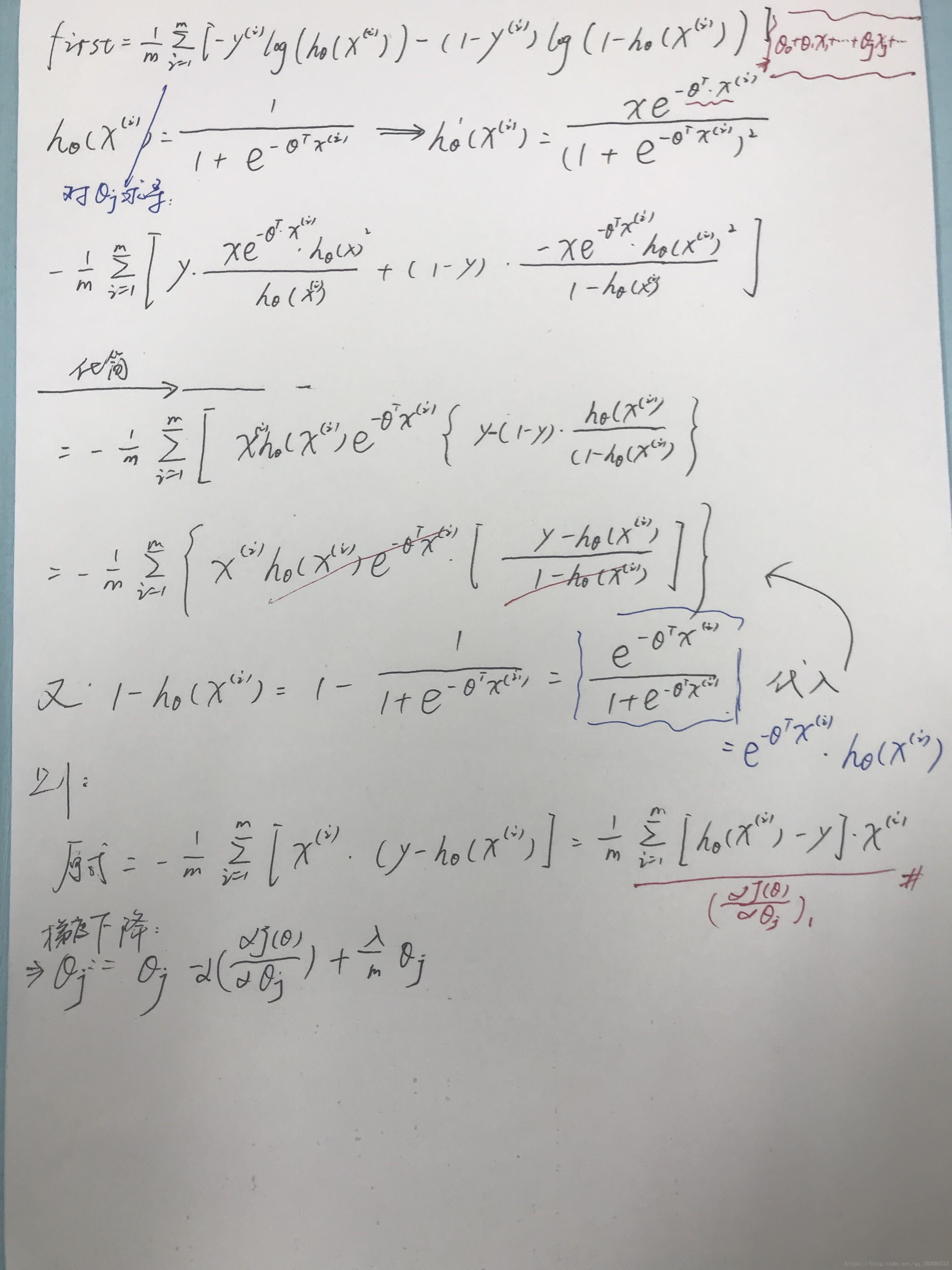- 吴恩达机器学习课后作业总结
- 代码参考黄海广
- 自己学习记录所用
- 数据集来自课后作业exercise2
一、线性可分的逻辑回归分类问题
- 初始化部分
import numpy as np
import pandas as pd
from pandas import Series,DataFrame
import matplotlib.pyplot as plt
import matplotlib
data = pd.read_csv('ex2data1.txt',names=['Exam1_Score','Exam2_Score','Admitte_Label'])
Label_classify = data.Admitte_Label.values == True #得到一个bool型数组(array)
Score=data[['Exam1_Score','Exam2_Score']] #要取出DataFrame的两列及以上的数据时,传入的是一个list,[...]。此时得到的输出仍是一个DataFrame
#若取出一个数据,如data[['Exam1_Score']]时,得到的仍是一个DataFrame
Admitted,Not_Admitted = Score[Label_classify],Score[~Label_classify]#对DataFrame传入一个bool型数组,会过滤掉行(即按行进行提取数据)
plt.figure(1,figsize=(12,8))
plt.scatter(Admitted['Exam1_Score'],Admitted['Exam2_Score'],c='black',marker='+',s=100,linewidths=3)
plt.scatter(Not_Admitted['Exam1_Score'],Not_Admitted['Exam2_Score'],c='yellow',marker='o',s=100,linewidths=3)结果如下:

从直观上很容易看到,这个是一个线性可分的二分类问题,即只要找出线性边界就能够对数据进行切分
- 采用逻辑回归,因此首先写出sigmoid函数:
def sigmoid(z): #s函数
return 1/(1+np.exp(-z)) 对于逻辑回归,我们知道其代价函数为:
J(θ)=1m∑mi=1Cost(hθ(x(i),y(i)))
J
(
θ
)
=
1
m
∑
i
=
1
m
C
o
s
t
(
h
θ
(
x
(
i
)
,
y
(
i
)
)
)
,其中
Cost(hθ(x),y)={−log(hθ(x)),if y=1−log(1−hθ(x)),if y=0
C
o
s
t
(
h
θ
(
x
)
,
y
)
=
{
−
l
o
g
(
h
θ
(
x
)
)
,
i
f
y
=
1
−
l
o
g
(
1
−
h
θ
(
x
)
)
,
i
f
y
=
0
据此,写出代价函数和进行一次梯度下降后函数表达式分别如下:
- 代价函数:
def cost(theta,X,y):#代价函数,传入的theta待迭代更新,X为数据集,y为数据集对应标签
X = np.matrix(X)
y = np.matrix(y)
h_x = sigmoid(theta*X.T)
L = np.multiply(y.T,np.log(h_x))+np.multiply((1-y).T,np.log(1-h_x)) #np.log(X)是分别对X中每一个元素求log,1-y会出现广播的情况
return (-np.sum(L))/(len(X))- 进行一次梯度下降后的表达式(即对于某一时刻的 θ θ 得到的导数–> 1m∑mi=1(hθ(x(i)−y(i))x(i)j 1 m ∑ i = 1 m ( h θ ( x ( i ) − y ( i ) ) x j ( i ) ):
def costgradient(theta,X,y):
theta = np.matrix(theta)
X = np.matrix(X)
y = np.matrix(y)
gradient_value= np.sum(np.multiply((sigmoid(X*theta.T)-y),X),axis=0)/(len(X))
# theta = theta - alpha*gradient_value[i,:]
return gradient_value- 用SciPy’s truncated newton(TNC)实现寻找最优参数
import scipy.optimize as opt
result = opt.fmin_tnc(func=cost, x0=theta, fprime=costgradient, args=(X, y)) ##(暂时不太明白)
result #result中,第一个数是更新后的theta
##result:
(array([-25.16131861, 0.20623159, 0.20147149]), 36, 0)- 进行预测——由于是二分类问题,因此只有两个标签(0、1),因此,只需根据sigmoid函数的状态直接对数据进行分析即可:
def predict(theta,X):
X = np.matrix(X)
theta = np.matrix(theta)
z = X*theta.T
h_x = sigmoid(z)
return [1 if h_x[i] >= 0.5 else 0 for i in range(len(np.array(h_x)))]测试:
predict_score = np.array(predict(result[0],X))
true_score = y.values.ravel()
predict_out = np.array([1 if ((i==1 and j ==1) or (i==0 and j ==0)) else 0 for i,j in zip(predict_score,true_score)])
ratio = sum(predict_out == 1)/len(predict_out)
print("accuracy is {0}%".format(ratio*100))- 找出决策边界
X×θ=0 X × θ = 0 (this is the line)
因此对于只有两个特征的这一情况,有:
θ0+θ1x1+θ2x2=0 θ 0 + θ 1 x 1 + θ 2 x 2 = 0
将 x2 x 2 看为y,则:
y=−θ0θ2−θ1θ2x1 y = − θ 0 θ 2 − θ 1 θ 2 x 1
据此,可得到:
theta_opt = result[0] #由scipy.optimize函数得到的经过梯度下降后更新的theta数据
##result[0] ----->
array([-25.16131861, 0.20623159, 0.20147149])
theta_opt.tolist()/result[0][0]
###----->
array([ 1. , -0.00819637, -0.00800719])
coef = (-result[0]/result[0][-1]).tolist()
print(coef)
###[124.88774020181867, -1.02362667995475, -1.0]
x = np.arange(100, step=0.1)
f_x = coef[0] + coef[1]*x
##可视化
plt.figure(3,figsize=(12,8))
plt.scatter(Admitted['Exam1_Score'],Admitted['Exam2_Score'],c='black',marker='+',s=100,label='Admitted',linewidths=3)
plt.scatter(Not_Admitted['Exam1_Score'],Not_Admitted['Exam2_Score'],c='yellow',marker='o',s=100,linewidths=3,label='Rejected')
plt.plot(x,f_x)
plt.xlim(30,100)
plt.ylim(30,100)
plt.title('Decision Boundary')
plt.xlabel('Exam1_Score')
plt.ylabel('Exam2_Score')
plt.legend(['Boundary','Admitted','Rejected'])
二、正则化逻辑回归
data2=pd.read_csv('ex2data2.txt',header=None, names=['Test 1', 'Test 2', 'Accepted'])
plt.figure(4,figsize=(12,8))
plt.scatter(positive_test.iloc[:,0],positive_test.iloc[:,1],c='black',marker='+',s=100,linewidths=3,label='y=1')
plt.scatter(negtive_test.iloc[:,0],negtive_test.iloc[:,1],c='yellow',marker='o',s=100,linewidths=3,label='y=1')
plt.xlim(-1,1.5)
plt.ylim(-0.8,1.2)
plt.xlabel('Microchip Test 1')
plt.ylabel('Microchip Test 2')
plt.title('lambda = 1')
plt.legend(['y=1','y=0'])
feature mapping(特征映射)
polynomial expansion
for i in 0..i
for p in 0..i:
output x^(i-p) * y^p

据此,有:
def feature_mapping(x, y, power, as_ndarray=False):
# """return mapped features as ndarray or dataframe"""
# data = {}
# # inclusive
# for i in np.arange(power + 1):
# for p in np.arange(i + 1):
# data["f{}{}".format(i - p, p)] = np.power(x, i - p) * np.power(y, p)
data = {"f{}{}".format(i - p, p): np.power(x, i - p) * np.power(y, p)
for i in np.arange(power + 1)
for p in np.arange(i + 1)
}
if as_ndarray:
return pd.DataFrame(data).as_matrix()
else:
return pd.DataFrame(data)
regularized cost(正则化代价函数)
def RegularCost(theta,X,y,lamta):
X = np.matrix(X)
y = np.matrix(y)
theta = np.matrix(theta)
return cost(theta,X,y)+lamta*np.sum(np.power(theta[:,1:theta.shape[1]],2))/(2*len(X))regularized gradient(正则化梯度)
def regularized_gradient(theta, X, y, l=1):
# '''still, leave theta_0 alone'''
theta_j1_to_n = theta[1:]
regularized_theta = (l / len(X)) * theta_j1_to_n
# by doing this, no offset is on theta_0
regularized_term = np.concatenate([np.array([0]), regularized_theta])
return gradient(theta, X, y) + regularized_term其余步骤类似上文
三、多类分类问题
- 吴恩达机器学习exercise3
初始化工作,引入scipy包来打开.mat文件
import numpy as np
import pandas as pd
import matplotlib.pyplot as plt
from scipy.io import loadmat
data = loadmat('ex3data1.mat')注意:
如果用的引用是import scipy而不是from scipy.io import loadmat,那么,调用时,使用scipy.io.loadmat时会报错(why?)
def lrCostFunction(theta,X,y,learningRate):
基本初始化操作:
(1)建立包含正则化的代价函数lrCostFunction(theta,X,y,learningRate),方法类似上面
(2)建立包含正则化的梯度计算函数RegularCostGradient(theta,X,y,lamta)
(3)构建One-Vs-All多分类器
对于分类器:
现在我们已经定义了代价函数和梯度函数,现在是构建分类器的时候了。 对于这个任务,我们有10个可能的类,并且由于逻辑回归只能一次在2个类之间进行分类,我们需要多类分类的策略。 在本练习中,我们的任务是实现一对一全分类方法,其中具有k个不同类的标签就有k个分类器,每个分类器在“类别 i”和“不是 i”之间决定。 我们将把分类器训练包含在一个函数中,该函数计算10个分类器中的每个分类器的最终权重,并将权重返回为k X(n + 1)数组,其中n是参数数量。
- 函数应该返回一个
Θ∈RK×(N+1)
Θ
∈
R
K
×
(
N
+
1
)
所有的分类参数,K为所有可能的类别,N为样本的特征数
-
Θ
Θ
对应于一个类的学习逻辑回归参数。
- 注意:该函数的y参数是从1到10的向量标签,我们将数字0映射到10
from scipy.optimize import minimize
def oneVsAll(X,y,num_labels,learning_rate): #输入的X,y是未经过插入Ones的原始数据和对应数据集的标签
rows = X.shape[0]
params = X.shape[1]
# k X (n + 1) array for the parameters of each of the k classifiers
all_theta = np.zeros((num_labels, params + 1))#生成(num_labels)*(params + 1)的初始l零矩阵
# insert a column of ones at the beginning for the intercept term
X = np.insert(X, 0, values=np.ones(rows), axis=1)#对X插入Ones数据
# labels are 1-indexed instead of 0-indexed
for i in range(1, num_labels + 1):#一个i代表一种分类器的标号(i=1表示是第一种分类器)
theta = np.zeros(params + 1)
y_i = np.array([1 if label == i else 0 for label in y])#每遍历到一个分类器,就找出这个分类器在原始数据标签中的位置
y_i = np.reshape(y_i, (rows, 1))
# minimize the objective function
fmin = minimize(fun=lrCostFunction, x0=theta, args=(X, y_i, learning_rate), method='TNC', jac=RegularCostGradient)#对当前的分类器找出最小的theta
all_theta[i-1,:] = fmin.x#找出一组theta则记录一组
return all_theta
我们现在准备好最后一步 - 使用训练完毕的分类器预测每个图像的标签。 对于这一步,我们将计算每个类的类概率,对于每个训练样本(使用当然的向量化代码),并将输出类标签为具有最高概率的类。
def predict(X,all_theta):
X = np.matrix(X)
all_theta = np.matrix(all_theta)
h = sigmoid(X*all_theta.T)
h_max = np.argmax(h,axis=1)
h_max = h_max+1
return h_max
def predict_all(X, all_theta):#对于已经找到的theta,对应的是使得代价函数cost最小时候的最优权重theta数值;因此将X*theta.T通过sigmoid函数后,
#sigmoid输出的数值y对于y轴上的10个标签,每个标签都会得到一个数据,判断最大值的标签对应的位置,即表示此时predict
#所识别的数字是多少
rows = X.shape[0]
params = X.shape[1]
num_labels = all_theta.shape[0]
# same as before, insert ones to match the shape
X = np.insert(X, 0, values=np.ones(rows), axis=1)
# convert to matrices
X = np.matrix(X)
all_theta = np.matrix(all_theta)
# compute the class probability for each class on each training instance
h = sigmoid(X * all_theta.T)
# create array of the index with the maximum probability
h_argmax = np.argmax(h, axis=1)#1代表行--即找出每一行最大值对应的索引的位置,表示找出K个预测值中,可能性最高的一个预测值,当作此时的模型预测输出值。h_argmax在这里是(5000,1)的矩阵
# because our array was zero-indexed we need to add one for the true label prediction
h_argmax = h_argmax + 1
return h_argmax测试输出:
y_pred = predict(X, all_theta)
correct = [1 if a == b else 0 for (a, b) in zip(y_pred, data['y'])]
accuracy = (sum(map(int, correct)) / float(len(correct)))
print ('accuracy = {0}%'.format(accuracy * 100))
###
accuracy = 94.46%注意:
由于y是uint8类型的数据,因此-np.multiply(y,np.log(h))和np.multiply(-y,np.log(h))是不相等的
-why:
uint8表示变量是无符号整数,范围是0到255.
uint8是指0~2^8-1 = 255数据类型,一般在图像处理中很常见。
如:
yy = np.arange(9,dtype=np.uint8).reshape(9,1)
yy
##
array([[0],
[1],
[2],
[3],
[4],
[5],
[6],
[7],
[8]], dtype=uint8)
-yy
##
array([[ 0],
[255],
[254],
[253],
[252],
[251],
[250],
[249],
[248]], dtype=uint8)因此,对于这样的数,不仅仅是相差了一个符号。即:
-若这样写:lrCostFunction(theta,X,y,learningRate)函数:
def lrCostFunction(theta,X,y,learningRate):
X = np.matrix(X)
theta = np.matrix(theta)
y = np.matrix(y)
h = sigmoid(X*theta.T)
reg = (learningRate / (2 * len(X))) * np.sum(np.power(theta[:,1:theta.shape[1]], 2))
return -np.sum(np.multiply(y,np.log(h))+np.multiply((1-y),np.log(1-h)))/len(X)+reg ##错误
###正确答案####
return np.sum(np.multiply(-y,np.log(h))-np.multiply((1-y),np.log(1-h)))/len(X)+reg表面上看逻辑没有问题,但是由于忽略了-np.multiply(y,np.log(h))和np.multiply(-y,np.log(h))是不相等的这个问题,导致答案是不正确的
附:
由:
regularized cost(正则化代价函数)
推导:
regularized gradient(正则化梯度)
如下:























 725
725

 被折叠的 条评论
为什么被折叠?
被折叠的 条评论
为什么被折叠?








